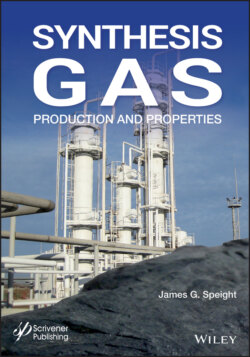Читать книгу Synthesis Gas - James Speight G., James G. Speight - Страница 45
2.5.2 Feedstock Devolatilization
ОглавлениеThe devolatilization (or pyrolysis) process commences at approximately 200 to 300°C (390 to 570°F), depending upon the nature and properties of the feedstock. Volatiles are released and a carbonaceous residue (char) is produced, resulting in up to 70% weight loss for many feedstocks. The process determines the structure and composition of the char, which will then undergo gasification reactions.
In a gasifier, the feedstock particle is exposed to high temperatures generated from the partial oxidation of the carbon. As the particle is heated, any residual moisture (assuming that the feedstock has been pre-fired) is driven off and further heating of the particle begins to drive off the volatile gases. Discharge of the volatile products will generate a wide spectrum of hydrocarbon derivatives ranging from carbon monoxide and methane to long-chain hydrocarbon derivatives comprising tars, creosote, and high-boiling oil. The complexity of the products will also affect the progress and rate of the reaction when each product is produced by a different chemical process at a different rate. At a temperature above 500oC (930oF) the conversion of the feedstock to char and ash and char is completed. In most of the early gasification processes, this was the desired byproduct but for gas generation the char provides the necessary energy to effect further heating and – typically, the char is contacted with air or oxygen and steam to generate the product gases. Furthermore, with an increase in heating rate, feedstock particles are heated more rapidly and are burned in a higher temperature region, but the increase in heating rate has almost no substantial effect on the mechanism (Irfan, 2009).
